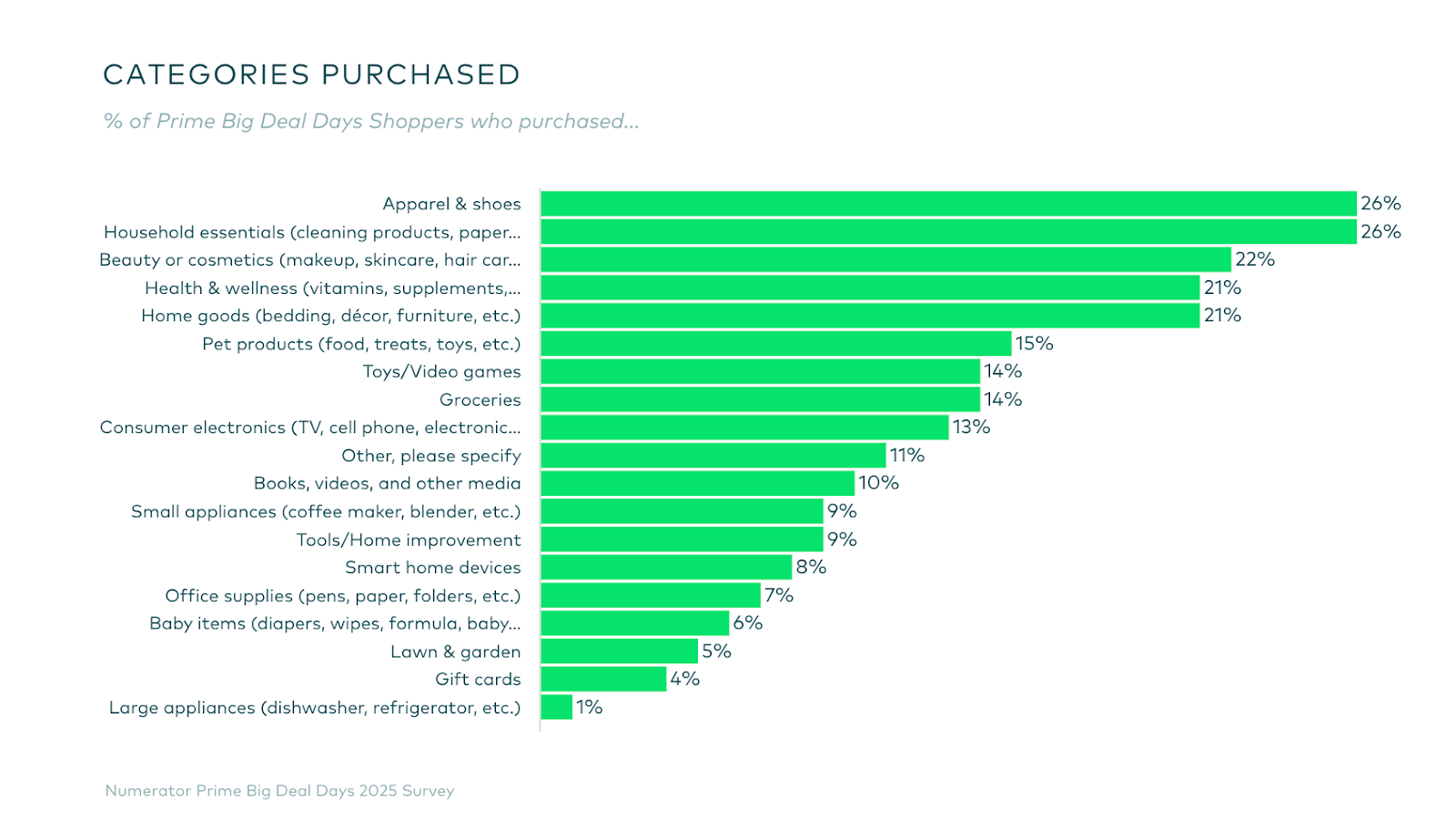The Prime Big Deal Days (PBDD) event, held October 7–8 in the US, proved once again to be a flurry of sales and opportunities for brands. According to Numerator, PBDD 2025 saw 90% of Amazon shoppers aware of the event, with 35% citing it as their main reason for shopping and 58% expressing high satisfaction with deals. Many shoppers (61%) also participated in July Prime Day, finding the deals largely similar.
This Amazon event served as an early start to holiday shopping, with 23% buying holiday gifts. Shoppers primarily used this opportunity to purchase items they had been waiting to buy on sale, or to acquire everyday necessities. Top categories included apparel, household essentials, beauty, health & wellness, and home goods. Also, 56% of consumers compared prices at other retailers like Walmart and Target, indicating a competitive shopping environment.

As the dust settles on this tentpole event, it's crucial to understand its impact and what it means for your brand as we gear up for Cyber Week and the remainder of Q4. In this blog post, we break down the biggest PBDD 2025 takeaways and offer key recommendations to optimize your strategy.
Key Takeaways from Prime Big Deal Days 2025
PBDD 2025, while perhaps not reaching the dizzying heights of the main July Prime event in terms of sheer volume, still proved to be a significant success for brands that approached it strategically.
Our analysis of performance metrics reveals several crucial insights for future planning, with two key takeaways standing out:
1. Strategic Investment in Discounts and Advertising Drove Significant Gains
Brands that invested in generous discounting and a strong advertising approach saw substantial gains during Prime Big Deal Days 2025.
2. Strong Performance Despite Lower Volume and Orders (Compared to July Prime)
While Prime Big Deal Days 2025 did not achieve the same volume or order numbers as July Prime Day, the reduced competition and fewer promotions allowed participating brands to achieve strong performance.
Shopper Engagement Surged on Day 1
Shopper engagement was exceptionally strong on Day 1 of US Prime Big Deal Days, with a remarkable 120% year-over-year increase in Click-Through Rate (CTR) and a 26% rise in clicks. Minimal increases to Cost Per Click (CPC) allowed brands to effectively capture significant traffic. Initial budgets were rapidly depleted early in the morning, with some accounts exhausting $100 in under an hour.
Unlike 2024, Day 1 of 2025 outperformed Day 2 in terms of Spend, Sales, Clicks, and Orders. While Day 2 of PBDD experienced a final surge at the end of the day, it was insufficient to surpass Day 1's performance.
Interestingly, Impressions were down year-over-year. Despite fewer searches, the content shoppers encountered in the search results clearly piqued their interest, leading to higher click rates.
Beauty Category Shone Despite Reduced Participation
The beauty category experienced a notable shift in participation during this year's Prime Big Deal Days, with significantly fewer brands joining the event. This reduced engagement might be attributed to the underwhelming performance of the beauty category during the July Prime Day or in anticipation of the upcoming Beauty Haul event in late October.
However, this decrease in competition and fewer deals created a unique opportunity for participating brands. Those that did take part were highly successful in capitalizing on the generated traffic, with several beauty brands exceeding Amazon's forecasts for Prime Big Deal Days and demonstrating strong year-over-year growth.
Conversion Rates and Ad Revenue Went Up
The increased click volume translated into improved conversion rates, up 5% from July Prime and 7% year-over-year. This surge in clicks and conversions resulted in a 29% increase in spend and 23% higher ad revenue YoY.
The limited timeline of a two-day PBDD likely contributed to this positive performance by motivating shoppers to make immediate purchases rather than only adding to cart and delaying purchasing decisions.

PBDD: Advertising & Retail Media Insights
Our analysis provides a comprehensive look into the advertising and retail media performance during PBDD, including detailed breakdowns of key metrics and crucial insights into shopper behavior.
CPC and AOV Breakdown
- Beauty category, specifically hair care, experienced reduced CPCs year-over-year, indicating decreased beauty brand participation and investment.
- While the overall Average Order Value (AOV) declined year-over-year, it remained higher compared to the July Prime Day event.
Add to Cart and PBDD Shopper Approach
- Following the first day of Prime Big Deal Days, we saw around a 20% lift in Add to Cart (ATC) compared to the previous monthly average.
- A substantial portion of shoppers did not limit their price comparisons to Amazon alone. Over 50% of these consumers actively cross-referenced prices on Walmart's platform. Also, around one-third of PBDD shoppers extended their product comparisons to include offerings at Target. This multi-platform shopping behavior suggests that even during Amazon's major sales event, a considerable number of consumers are highly price-sensitive and willing to explore various retailers to secure the best deals.
- With an increasing number of retailers participating in shopping events like these, brands must develop a clear promotional and media plan. This plan should outline whether strategies will be entirely cohesive or entirely distinct. Overlapping, fragmented promotions can lead to consumers comparing options more frequently, which may result in higher prices and lower conversion rates.
Strategic Recommendations Heading into Cyber Week
As we transition into the crucial Cyber shopping period, it's essential to strategically prepare for continued success. Here are our top recommendations for your brand based on our Prime Big Deal Days key findings:
Audience Segmentation and Targeting
- Target Engaged Non-Converters: Create an audience of users who showed interest (clicked or searched for the brand) but didn’t convert during Prime Big Deal Days, leveraging the high engagement seen.
- Retarget Existing Customers: Build audiences of those who purchased during PBDD or are repeat customers. Focus messaging on promoting gifts they already love.
Campaign Optimization
- Refine Search Terms and Audiences: Identify search terms and audiences that underperformed on PBDD and either negate them or decrease investment in the lead-up to the Cyber shopping period.
Performance Analysis
- Increased Average Order Value (AOV): The increase in Average Order Value from July Prime (Prime Day) to October Prime (PBDD) is encouraging, indicating shoppers are more open and ready to spend. While YoY AOV was lower this PBDD than last, it likely contributed to the increase in clicks, conversion, and revenue.
Looking Ahead: Q4 Holiday Season
Now, let’s explore what PBDD performance signals for Cyber Week and upcoming holidays in Q4. Consistent with July Prime Day, deal sentiment remained stable, yet Average Order Values (AOVs) saw a 23% increase. This suggests a positive outlook for brands planning promotions, indicating a greater willingness among shoppers to spend more per order.
As with any major sales event, deals were a key driver of conversion. The rise in AOVs from July Prime Day to Prime Big Deal Days (PBDD) indicates shoppers' increased readiness to spend. A shorter promotional timeline appeared to positively impact Conversion Rates, Click-Through Rates, and AOVs.
The longer Cyber time frame may prove to be less productive from a CVR perspective, as shoppers have more time to consider. Though shoppers are reporting deal sentiment as stagnant compared to July Prime Day, it was not enough to deter them from buying, as CVR and Clicks were higher YoY and compared to July Prime.
Blue Wheel's Perspective: Brand Preparation Strategies
From a Cost per Click standpoint, many brands benefited from fewer Prime Big Deal Days participants; however, this trend is unlikely to continue into the Cyber sales period. To encourage more branded searches during the holidays, brands should begin nurturing shoppers immediately.
By increasing brand awareness and building retargeting pools with intentional messaging, brands can keep shoppers engaged over the next 4–6 weeks. This strategy will facilitate efficient and effective campaigns in November and December.
Final Thoughts
As the insights from Prime Big Deal Days 2025 clearly demonstrate the dynamic nature of holiday shopping, it’s crucial to translate these learnings into actionable strategies for Cyber Week and the remainder of Q4. The increased shopper engagement, improved conversion rates, and higher average order values signal a significant opportunity for brands that are well-prepared.
Don't miss out on the opportunity to capitalize on the momentum from Prime Big Deal Days. Connect with our Amazon Ads and Amazon DSP experts today to develop a custom strategy that will drive your brand's success throughout the holiday season.







.png)
.png)
